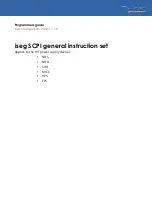
COMMAND KEYWORDS
Command keywords must exactly match the defined set for the device. The first field in a command is always the keyword.
Leading and trailing whitespaces are allowed and do not change the behavior of a command. The device evaluates commands
case-insensitive, so both uppercase, lowercase or mixed notations are possible.
Uppercase bold letters given in this manual must always be written, lowercase letters are optional. For example, the command
:
CO N F
i g u r e :
RA M P
:
V O L T
ag e
can be written in any of the following forms with the same meaning:
: C O N F : R AM P : V O L T
: c o n f : r a m p : v o l t
: C O N F I Gu r e : R A M P : v o l t A G E
: C O N F I G U R E :R A M P : V O L T
: c o n f i g u r e : r a m p : v o l t a g e
PARAMETERS
Order commands need parameters to specify the action to take. The parameter is always separated from the command with one
or more space characters. For example,
: V O L T
˽
1 0 0 <C R > <L F >
will set the voltage to 100 Volt.
The following types of parameters exist:
•
Number: <Number> means either an integer or a float number can be given here
•
String: A string without quotes (“)
•
Range: {0...63} means the values 0 up to 63 (both included) are possible parameters here
•
Enumeration: {125000|250000} means either 125000 or 250000 is a possible parameter here
COMMAND HIERARCHY
SCPI commands form a hierarchy or a tree, starting at the SCPI root, which is indicated by a colon “
:
”.
A command line is always terminated by the character sequence carriage return and line feed <CR><LF>. The first command in a
line always starts in the SCPI root, which means the first leading “
:
” can be omitted. So the following commands are both correct:
: V O L T
˽
ON <C R ><L F >
V O L T
˽
O N <C R ><L F >
Multiple SCPI commands can be given in one line, separated by a semicolon “;”. All following commands start in the same
hierarchy as the previous command, if no leading “:” is given. This can greatly reduce the amount of data transmitted to the HV
device. So the following two commands are identical:
: M E A S : V O L T ? ; : M E A S : C U RR ? <C R ><L F >
: M E A S : V O L T ? ; C U R R ? <C R ><L F >
For request commands, the answer follows the same principle: each part is separated with a semicolon “;”. So the complete
answer for one of the commands above could look like this:
1 2 3 . 4 5 6 V ; 1 . 2 3 4 5 E - 3 A <C R ><L F >
SCPI protocol common instruction set | Last changed on: 2020-11-10 |
www.iseg-hv.com
13/63













































